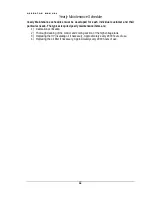
O P E R A T O R M A N U A L
24
7.
Check calibration at both half and full scale. If the customer facility calibration certification
requires more points of reference, follow those procedures instead of these.
Current Meter Re-calibration
1.
Locate the unit in a position that will allow easy reading of the meters.
2.
Remove the panel screws and support the panel vertically to gain access to the calibration
pot on the back of the front panel near the current meter..
3.
Zero the meter movement using the zero adjustment below the scale window.
4.
Perform the steps in Setting up the Equipment at the start of SECTION 2. Be sure to
ground power section and high voltage tank to a solid earth ground prior to connecting the
unit to input power.
5.
Connect the output cable to a calibrated reference meter with ability to read to the full output
current of the unit. A series limiting resistor should be used to allow adjusting the current in
controllable increments. Be sure to ground the low side of the meter.
6.
Raise the output current to one half scale on the unit meter. Adjust R6, located on the base
of the control as required.
7.
Check calibration at both half and full scale. If the customer facility calibration certification
requires more points of reference, follow those procedures instead of these.
Oil Insulated High Voltage Tanks
The oil-filled tanks in all the VLF SERIES of hipots are field serviceable. The only requirement is that the
tank must be oil filled under vacuum at re-assembly. The parts to service the tank are available from
HIGH VOLTAGE, INC. at the address noted on the inside front cover of this manual.
The oil level in the tank should be .50 - .75 inches from the lid when the oil temperature is 20
°
C.
Weekly Maintenance Schedule
Weekly maintenance must be developed for each individual customer and their particular
needs. The typical regular maintenance items are:
1)
Keep output cable insulation and HV tank well clean. Use a clean cloth and mild solvent
oil (like WD40) to remove dirt and carbon marking from use.
2) Watch for accumulation of dust or foreign matter in the cooling ports on the HV tank.
Clean with a damp cloth as necessary.
3) Watch for loose clamps on the interconnect cable. Tighten as necessary.






































